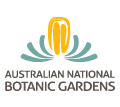 |
In Flower This WeekA weekly news-sheet prepared by a Gardens volunteerNumbers in brackets [ ] refer to garden bed 'Sections'. Plants in flower are in bold type. |
 |
In Flower This WeekA weekly news-sheet prepared by a Gardens volunteerNumbers in brackets [ ] refer to garden bed 'Sections'. Plants in flower are in bold type. |
18 January 2002
Be amazed at all the colourful flowers edging Banks Walk. This walk starts near the Bottom Depot and will include many more extraordinary flowers. Baeckea virgata ‘Howie's Feathertips’ [Section 124] has a covering of tiny white flowers over the medium size shrub while opposite, the kangaroo paws, Anigozanthos flavidus [Section 126], vary in colour from matt green to others with a mix of red and green, all on long upright stems. Myoporum parvifolium [Section 117] is a ground cover with an abundance of small white flowers, falling over the retaining wall.
The Rock Garden has an abundance of flowers including Lythrum salicaria [Section 15Q], with spikes of purple flowers, seen in front of the waterfall. Above the rockface is a small grass tree, Xanthorrhoea macronema [Section 15D], a tufted plant with fine arching leaves and cream flower spikes on upright stems. The Field Lily, Crinum angustifolium [Section 15D], is quite startling with attractive white flowers and red anthers atop erect stems surrounded by long limp leaves. On the Rock Garden horizon the beauty of the rust-orange ‘paw’ flowers of Anigozanthos flavidus [Section 15H] can be admired.
Taking the zigzag path up past the covered shelter, see Banksia lemaniana [Section 37]. This species has greenish-yellow flower spikes and, unlike most banksias which have upright flower spikes, these are pendent. Eremophila racemosa [Section 121] is a colourful shrub bearing orange buds mixed with red bugle flowers. Banksia media [Section 37] is a misshapen old shrub presenting the first of its dark mustard coloured juvenile flower spikes which will mature to quite large cylindrical specimens. Opposite the Rainforest Gully, Banksia speciosa [Section 37] is an open shrub with long, deeply toothed narrow leaves and flower spikes which mature from the base to the tip, coloured shades of lemon. Not so pleasant are the exposed tree roots and dead trees resulting from a fungus causing Armillaria Root Rot. Down hill is a stand of Crowea ‘Festival’ [Section 123] dense rounded shrubs graced with bright pink star flowers.
Crossing over the pleasantly cool Rainforest Gully, follow the narrow path which winds up to the grass trees, Xanthorrhoea glauca subsp. glauca [Section 62] with swaying green grass skirts and tall brown and cream flower heads. An orchid, Cymbidium canaliculatum [Section 62], growing on a tree stump, has dense clusters of tough leathery leaves and spikes of small brownish-green flowers. A bed of Rhododendron macgregoriae x lochiae [Section 62] is bright with clusters of red trumpet flowers. (Seen also in a pot outside the Visitor Centre doors.)
From the marked path parallel with the Rainforest path, compare Hibiscus splendens [Section 219], bearing pretty pink flowers with white veins, Hibiscus divaricatus, [Section 219] with startling yellow flowers, and Hibiscus heterophyllus [Section 219] with pink-edged white flowers ... all really lovely. Along this path too, is Cassinia subtropica [Section 219], a fairly large open shrub well covered with flower heads of small rust coloured flowers.
Warm days, wonderful flowers ... Barbara Daly.
| Return to: | Australian National Botanic Gardens | Previous
'In Flower' Weeks |